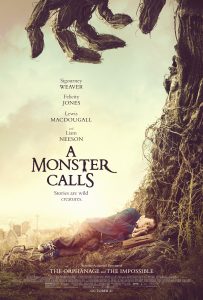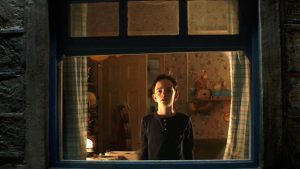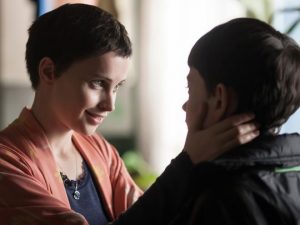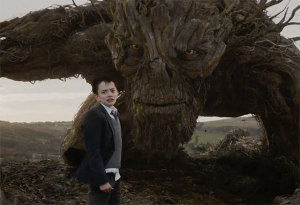
Upon describing the premise of “A Monster Calls” to a friend, she questioned why I was so excited to see it. How could I be overjoyed at the prospect of seeing a film in which a bullied child copes with his dying mother’s cancer through an imaginary monster? Surely that is a recipe for tears, cooked up via misery and torment. Do we not go to the movies to escape from the harshness of reality? Why be enamored with a tale of anguish?
These are the same questions posed by the bullied child when the monster appears. Conor (Lewis MacDougall) does not call upon the monster, at least not consciously. It appears outside his bedroom window one night, taking the form of the yew tree that resides atop the hill. Its arrival shakes the foundation of the village, each step causing a thunderous quake. Branches are ripped from their foundation, the inner bark and cambium cell layers smoldering with fiery heat. Eyes begin to form as if brutishly carved. It peers into the boy’s window, taunting him as the wind gushes through. He dares him to run to his mother for protection, only for the scared boy to fight back with defiance. Nobody brings his mother into a quarrel lest they go through him.

Curiously, the monster means no harm to the young man. It is not a villainous beast intent on pelting the poor chap with apples, as seen in “The Wizard of Oz.” Nor is it going to rip and claw at its victim with bloodlust ala “The Evil Dead.” It’s not even looking for a human sacrifice like the one in “The Guardian.” All the creature is after is an audience for his stories. He has reached out to Conor as he feels he needs these wild beasts he calls stories.
All of the stories are bleak and downtrodden. They are dolled up via vivid watercolors, which sprinkle across the screen in colorful fashion. One revolves around a majestic kingdom stricken with greed and treachery. A beloved King and a farmer’s daughter are believed to be poisoned by a power-hungry Queen, only for the championed Prince to be the true culprit. He goes unpunished for his crimes, the Queen taking the fall and he taking the glory. The apothecary also evades punishment for denying dying twins a cure for their illness, a result of contempt of their father whose preaching ruined the pharmacists’ career. The invisible man who lashes out at those who dismiss is still puzzlingly alone after asserting himself. Conor can’t make heads or tails of the stories’ purpose, finding them to be a waste of time. He has a sick mother (Felicity Jones) to tend to; he has no time for grim tales, nor to tell one of his own.

The monster, whose gravelly voice is provided by Liam Neeson, makes his presence felt whenever he deems fit. It’s always at 12:07, but the dates are unsystematic. He tends to choose the worst times, such as when Conor is arguing with his grandmother (Sigourney Weaver) or fending off school bullies. He leaves him be when his father (Toby Kebbell) comes to visit, failing to make his presence felt when referenced. It doesn’t take long for Conor to conclude that the monster is a figment of his imagination, a nightmarish concoction birthed from his subconscious. A fabrication so powerful it causes the boy to destroy his surroundings as the monster does in his fantasy.
If the monster is a nightmarish creature, why does it resort to telling only tall tales? The monster knows the scariest thing of all is the truth and all of his stories are imbued with it. Each took place in his presence over the years: the farmer’s daughter murdered within his shadowy comfort, the apothecary hiding behind his towering frame. The monster acts as God, punishing those he believed to be wrong. They always wound up being the victims, a moral on the grey area that is life. Humans are flawed, with no clear-cut heroes and villains. Those who seem evil on the surface may have justifiable qualms and those who seem wholesome may hide wickedness.

In telling the stories, the monster is trying to reach to the young boy. For Conor is like the Prince, seemingly virtuous but selfishly wanting to fulfill his desires. He views his grandmother as the Queen, a seemingly cold-hearted witch who wants his mother out of the picture. He fails to realize she only pines over her daughter, knowing full-well her time is coming to an end. All she wants to do, as does the father, is prepare Conor for the inevitable. He would rather hide and sabotage others if it meant keeping his mother alive. He sheepishly buys into the belief that there is a cure, all the while rejecting those who are trying to help him and his mother. Just as the preacher did to the apothecary, blind faith resulted in neglected solace. And just as the invisible man strengthened his isolation by having his voice heard, the twelve-year-old boy does the same, pushing away those closest to him as he physically clashes with his bullies, both literal and perceived.
Siobhan Dowd conceived the novel during her own terminal illness as a way of facing her grief. While others used stories to escape from reality, she crafted one to challenge it. Just as the Brothers Grimm used twisted folklore as a dark allegory, she concocted a bleak fantasy to act as catharsis. By digesting the morose and coming to grips with the darkness of the world, we are able to find comfort in our sorrow. We reject these stories, rushing to the comfort of an upbeat fairy tale in which good conquers evil and everyone lives happily ever after. While there is nothing inherently wrong with those tales, they are not always the medicine we need. Sometimes, we need the cold fable to keep us grounded. To act as a reminder of life’s woes; to challenge us to find the beauty in pain. It is uplifting not by chicanery, but in familiarity. We, like the invisible man, don’t feel so alone when we witness stories in which others share our problems. We find the consolation we seek by sharing our pain, not by bottling it.

J.A. Bayona understands Dowd’s intent and lovingly brings it to life! With the aid of cinematographer Oscar Faura, he cakes the film in moody grays and ominous shadows. A shallow focus is integrated often, making the world around Conor feel fuzzy and foreign. The monster’s shadow at times swallows the boy whole, a symbolic gesture of the monster within him surfacing. Dreary skies hover over crumbling buildings and the shattering of the Earth’s core, representing the downfall of Conor’s psyche. The watercolors shine a glimmer of hope into the proceedings, the lavish kingdom in which the Prince resides popping with warming colors. It slowly grows dark, leading into the charcoalish Hell of the Industrial Revolution, eventually transmuting into the glum society Conor inhabits. The cinematography is overpowering, at times filling in for the drama that the blunt dialogue may not fully develop. Even that flaw is dismissible, as the blunt dialogue reflects Conor’s acceptance of truth. He’d rather hear of a problem’s solution forthright as opposed to tackling it himself.
Lewis MacDougall joins the ranks of fellow stellar performers, such as Julian Dennison and Angourie Rice, taking comfortable residence in the Renaissance of child actors. He strikes the right balance between anger and sadness, carrying the drama on his back like a pro. His journey of self-discovery infects the audience, causing myself to feel his pain. As the film progressed and his mother’s cancer got worse, I could feel a lump slowly forming in my throat, just as I seen one develop in his. He conveys so much sorrow in his eyes and his sullen demeanor, a trait of a seasoned vet, not a beginner. He stands tall alongside the likes of Felicity Jones and Sigourney Weaver, the latter’s subtlety attempting to act circles around him, but he keeps up the pace. He develops robust chemistry with the monster, but a wonderful CGI creation that stood not before him. I believed the two shared the same space by MacDougall’s interactive performance and attention to geography. Liam Neeson’s superb voice acting bolsters this believability: the gravelly tone made endearing by the soft tempo bellowing underneath.

Through the careful direction of Bayona and the solicitous screenplay by Patrick Ness (adapted from the novel he penned from Dowd’s idea), “A Monster Calls” is beautifully brought to screen with compassion and intelligence! It challenges the viewer to cope with depression through evocative fantasies. It’s a whirlwind of imagination and catharsis; the most humanistic fantasy. It is a reminder why stories like this can be so enticing: the reality mixed with fantasy is the perfect medicine for an ailing soul!
P.S. The film is rated PG-13 for thematic content and some scary images. Despite that, I would recommend it for children. Maybe not those in early elementary, but ten and up is a suitable audience. The fantastical imagery will enrapture their attention while the morality will provoke their minds. Growing children need to learn to handle the hardships of life and there’s no better and safer way than the comfort of a compelling story such as this.
Final Rating: A
